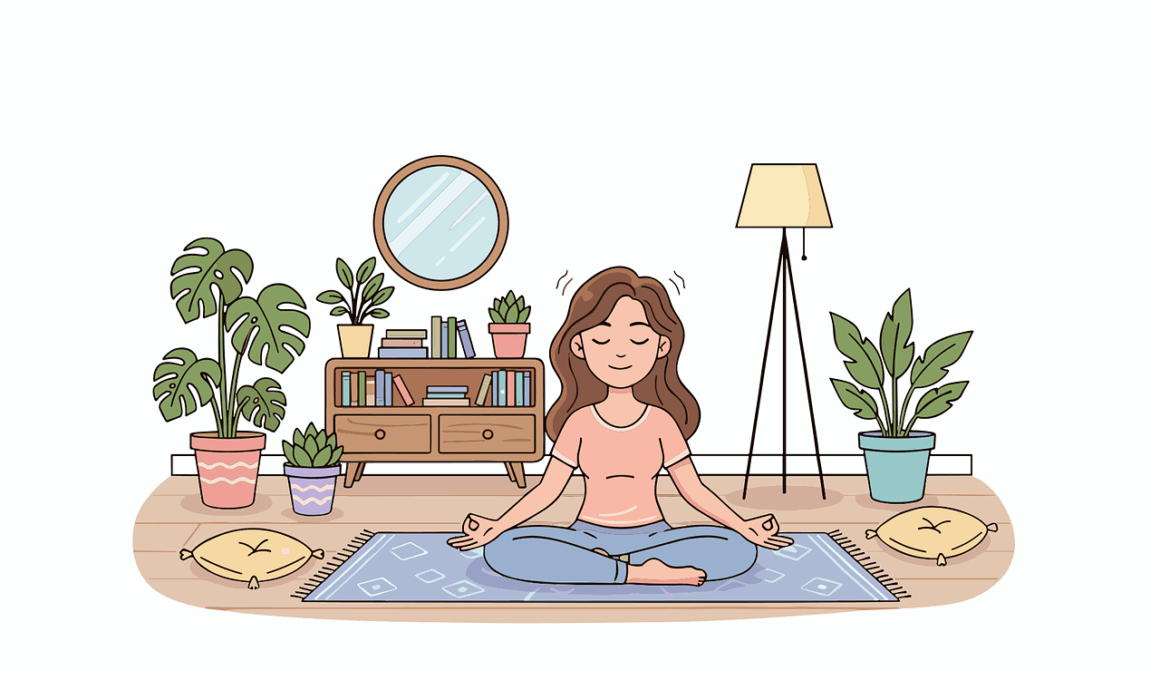Mindful Breathing for Seniors: Techniques and Benefits
Breathing exercises are essential for maintaining optimal health, particularly for seniors. Mindful breathing combines relaxation with deep and conscious breath control, engaging a body’s respiratory system fully. This practice has remarkable benefits, including increased oxygen flow, which invigorates the blood and organs. Furthermore, mindful breathing can alleviate anxiety, a common issue faced by older adults. When seniors focus intentionally on their breath, it can serve as a powerful method for calming the mind. Engaging in breathing exercises helps reduce symptoms of stress and fosters a sense of well-being. Active participation in these practices can also enhance lung capacity, which tends to decline with age. Additionally, developing a routine around mindful breathing can encourage mindfulness in general, improving focus and peace of mind. Studies have shown that older adults who practice regular, mindful breathing techniques experience better sleep and reduced blood pressure. To start, seniors can simply sit comfortably, aiming to take deep inhales followed by slow exhales. Overall, incorporating mindful breathing into one’s daily routine not only supports respiratory health but also improves mental clarity and emotional balance in seniors.
Benefits of Mindful Breathing
The benefits of mindful breathing extend beyond mere relaxation. First, it strengthens the diaphragm, leading to improved breathing efficiency, which is crucial as age progresses. This efficiency enhances the overall quality of life and promotes energy levels. Additionally, mindful breathing reduces tension in the body, offering relief from chronic discomfort often associated with aging. Furthermore, practicing these techniques has emotional benefits, enabling seniors to manage feelings of loneliness and isolation. Creating a shared experience, seniors can practice mindful breathing in group settings, building social connections and combatting loneliness. The communal aspect of group exercises can significantly boost the emotional health of older adults. Engaging in these activities together cultivates a support network among peers. Moreover, this practice can empower seniors, sharing skills and techniques, which ultimately leads to improved self-esteem. Mindful breathing also aids in focusing one’s attention away from daily stresses, fostering a more serene mental state. To maximize benefits, engage in mindful breathing sessions during peaceful moments throughout the day, enriching physical and mental well-being holistically. This easy-to-adopt habit strengthens both connection to oneself and connection to others.
To effectively practice mindful breathing, individuals may utilize specific techniques tailored to their needs. One popular approach is diaphragmatic breathing, which emphasizes using the diaphragm effectively. To perform this method, seniors can sit in a comfortable position, one hand on the chest and the other on the abdomen. Inhale deeply through the nose for a count of four, ensuring that the abdomen rises while the chest remains still. Hold the breath for a count of four before exhaling slowly through pursed lips. Repeat this cycle for several minutes to experience optimal relaxation. Another beneficial technique is 4-7-8 breathing, ideal for calming the mind. Inhale for four seconds, hold for seven, and then exhale over eight seconds. A greater count during exhaling encourages relaxation, beneficial when tension builds. Additionally, seniors can incorporate visualization while breathing, imagining themselves in serene environments or recalling peaceful memories, further deepening their mindful experience. As with any new practice, consistency is key. Daily dedication to mindful breathing establishes peaceful routines that yield lasting benefits over time, ultimately supporting sustained health and emotional stability.
Overcoming Challenges
For seniors, commencing a new practice like mindful breathing may pose challenges, yet the rewards are worth the effort. Some seniors may initially struggle with concentration or physical limitations affecting their breath. It’s essential to approach these challenges with patience and adaptability. Adjusting the practice to individual comfort levels ensures that mindful breathing remains accessible. For instance, seniors who may struggle with mobility or pain can practice seated or reclining. Using supportive cushions aids in maintaining relaxation and comfort throughout exercises. Furthermore, audio guides or instructional videos can help seniors learn proper techniques while focusing solely on their breath, removing mental barriers. Overcoming distractions is another common challenge. It may help to create a tranquil space for practice; eliminating noise and interruptions enhances mindfulness. Gradually increasing the duration of sessions facilitates progress, ultimately leading to greater mastery of the technique. Having a breathing buddy or joining a local group can also motivate individuals, reinforcing accountability and commitment. Little by little, overcoming these obstacles solidifies mindful breathing as a regular practice that positively impacts seniors’ lives.
To incorporate mindful breathing into daily routines, seniors can designate specific times for practice, enhancing consistency. Morning sessions are particularly effective, setting a tranquil tone for the day. Even five to ten minutes can create a profound difference in mood and energy. Additionally, seniors should remain flexible and open to adjusting their routines as needed. Exploring different techniques allows individuals to find what resonates most with them; not all methods will suit every practitioner. The beauty of mindful breathing lies in its adaptability. Beyond home routines, seniors can practice mindful breathing in various settings, including during walks, at the park, or while waiting. This versatility makes it easier to integrate into a busy lifestyle. Cultivating awareness of one’s breath throughout the day fosters mindfulness beyond formal sessions. As seniors continue exploring this practice, they can notice significant positive shifts in their mental clarity, emotional balance, and physical health. Encouraging moments of stillness and mindful breathing provides an opportunity to reconnect with oneself, nurturing both body and mind amid a fast-paced world. Celebrate progress and be compassionate as one embraces the journey of mindful breathing and well-being.
Resources for Practice
Several resources are available to support seniors in their mindful breathing journey. Numerous online platforms feature guided meditations and breathing exercises specifically catered to older adults. These resources often include tutorials, instructional videos, and audio guides, making it easier for seniors to learn at their own pace. Popular apps like Headspace and Calm offer user-friendly interfaces to guide daily mindfulness practice. Additionally, many community centers and senior organizations host breathing classes or workshops, which foster camaraderie among participants while learning techniques together. This group setting enhances motivation and accountability. Printed materials such as books or handouts on mindful breathing can also serve as useful references that seniors can keep handy. Belonging to local clubs or online forums focused on mindfulness encourages sharing experiences and learning new techniques. Joining classes led by certified instructors provides additional benefits, ensuring proper guidance and support during practice. By investing time in exploring these resources, seniors can cultivate a rich, fulfilling relationship with mindful breathing, allowing them to experience its full range of benefits and wellness opportunities over time.
In conclusion, mindful breathing represents a powerful tool for enhancing the quality of life among seniors. The techniques outlined throughout this article are accessible and beneficial for improving not only physical health but also emotional well-being. Taking the initial step towards mindful breathing may feel daunting, but the rewards obtained through practice make it worthwhile. By adopting a patient approach and celebrating progress, seniors can harness the significant benefits of deep, conscious breathing. Over time, this practice enhances emotional resilience, alleviates stress, and fosters a better connection to oneself and the world around. All individuals, including seniors, have the right to feel good and live peacefully. By integrating breathing practices into daily routines, seniors can elevate their sense of joy and fulfillment. Furthermore, social connections can be enhanced through group activities centered around mindful breathing, promoting a sense of belonging. Ultimately, investing in mindful breathing practices cultivates a calmer, more balanced lifestyle, allowing seniors to navigate life’s ups and downs gracefully and with confidence. Embrace the journey of mindful breathing and experience the transformative impact it can have on one’s health and happiness.





